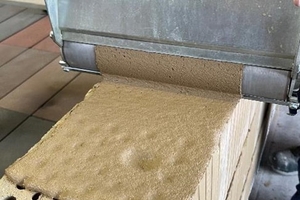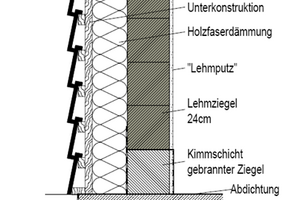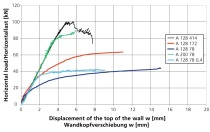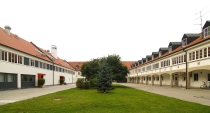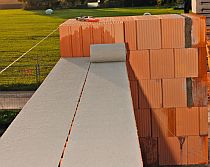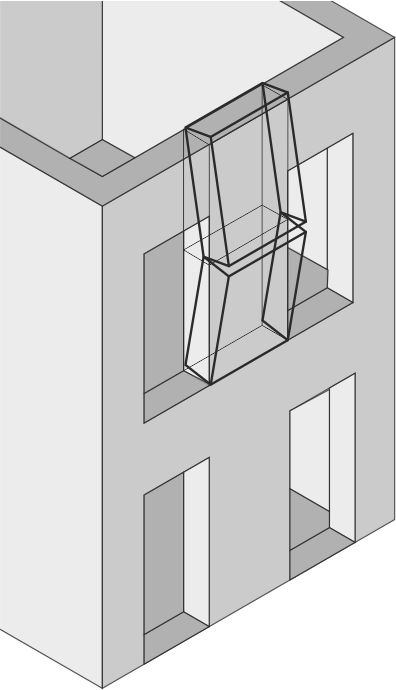Circular masonry becomes suitable for mass production
General type approval for clay block masonry using the thin-bed method in accordance with DIN 18940 for building class 4 20.05.2025Load-bearing earth block masonry (DIN 18940)
Building with clay is considered one of the most resource-conserving and energy-efficient construction methods. DIN 18940, which came into force in 2023, was the first standardized basis for load-bearing earth block masonry up to four storeys. Previously, however, only masonry with small-format clay blocks using the time-consuming thick-bed mortar method was permitted.
With the general type approval now granted to GIMA, load-bearing masonry with large-format clay blocks using the thin-bed method is officially possible for the first time. “This saves us more than a third of the cost-intensive working time compared to masonry with clay blocks using the thick-bed mortar method. This makes clay masonry economically competitive and proves that clay building materials can now stand on a par with conventional materials as practical industrial products,” says Maximilian Breidenbach, Head of Production & Corporate Development at ClayTec.
Healthy to live in, sustainable, fully recyclable
Loam consists of clay, gravel, sand and silt and is easy to process as a plastic mass with the right amount of water. As a building material, clay meets the highest ecological and building biology requirements: It is locally available, conserves resources and can be 100 percent recycled. Clay earth requires little energy to produce as it does not have to be fired.
In addition, clay earth significantly improves the indoor climate: it does not emit any harmful substances and naturally regulates air humidity by absorbing and releasing water vapor. Clay also offers good sound insulation and heat-retaining properties thanks to its mass.
CO2-neutral production of clay bricks
When shaping the clay vertically perforated bricks, GIMA follows the usual brick formats so that the existing brick production lines are used for manufacture. After shaping, clay bricks dry at approx. 80°C in the drying chambers and the subsequent firing process is completely eliminated. This means that the energy required for all production steps can be covered by electricity from GIMA's own photovoltaic systems and the plant's own heat recovery system.
Clay brick formats
GIMA clay vertically perforated bricks meet the requirements of compressive strength class 5 and can be used for both load-bearing and non-load-bearing walls. Thanks to conventional brick formats, they can be processed efficiently and quickly. The LZ11 and LZ17 clay blocks with widths of 115 and 175 millimetres are available for non-load-bearing interior walls. For load-bearing interior and exterior walls, GIMA produces formats with widths of 240, 300 or 365 millimetres.
Clay thin-bed mortar
The award-winning clay thin-bed mortar is an innovation from ClayTec and consists of building clay, other primary mineral raw materials and plant fibers that are ground and mixed. The clay thin-bed mortar requires a fraction of the production energy of mortars containing cement. Thanks to its solubility, once bonded masonry can be separated again without leaving any residue. The product can be processed like any conventional thin-bed mortar: the dry mix is mixed with water and then applied with standard thin-bed mortar slides, mortar rollers or application rollers to a thickness of 2 millimetres. The joints harden by drying alone.
Wall construction and processing
GIMA recommends planning external walls as a double-skin wall construction. In this way, the clay brick can make the most of its advantages for the indoor climate and is protected from external environmental influences in the long term. A bond-free wall assembly enables complete dismantling: on the outside, a curtain wall protects the clay bricks, which are bonded with clay thin-bed mortar. Inside, a clay plaster completes the circular wall structure so that all materials can be separated and recycled at the end of the building's life.
Clay construction also has advantages for the health of the workers: “For the contractor, working with natural materials such as clay bricks, clay adhesive and clay plaster is healthier than working with sometimes highly chemical building materials,” says Daniel Neuer, contractor of the GreenConceptLehm pilot project in Meißen, where GIMA clay vertically perforated bricks were used.
Circular economy
Clay bricks can be fully returned to the raw material cycle when using clay mortar and clay plaster. Even broken bricks can be fully recycled at any time. This means that new clay bricks can be produced from the material of old clay walls, thus avoiding the extraction of further raw materials. If a clay pit is no longer productive or the quality of the clay is no longer sufficient, GIMA immediately begins to renaturalize the area.
“One of the advantages of clay bricks is that they are a sustainable building material that can be returned to its original state at the end of its life cycle. You live healthily and the climate is naturally regulated. It's better to live in an adobe house than in any other,” says Prof. Dr. Wolfram Jäger, initiator of the GreenConceptLehm pilot project and former professor of structural design at TU Dresden.


